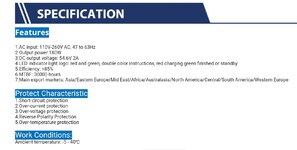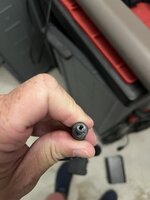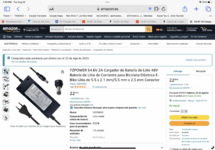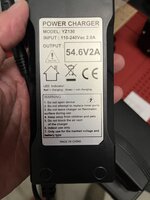You are using an out of date browser. It may not display this or other websites correctly.
You should upgrade or use an alternative browser.
You should upgrade or use an alternative browser.
Charger for Europe
- Thread starter Avbbva58
- Start date
Thank you very much for your extensive explanation. Attach is the back of the charger, only does 110. And the connector to the battery looks like it's on pin?Congrat's on getting your eBike to Euro - your Rde1Up can outrun Euro-Spec-Speed-Limited-eBikes. Euro DREAMS about going 28mph/45kmh.
Let me try to help - pleas take your Ride1Up 48V 2 Amp Charger - what is termed the "Brick" part - turn it over and look closely at that bottom panel.
The manufacturers markings are there - look for INPUT - most chargers will say - 100V-240V VAC 50-60Hz - which means that charger can be used in US -Euro = Asia - etc.
If your charger says 120-24VAC - do NOT the Step Down Transformer you have with your eBike charger - not a good thing - could fry your charger,'
'
What you need is the correct adapter plug to make the US 120V 3-Pin Plug to connect to the correct 220V wall socket in your part of Europe - or a electrcial cord with Euro Wallplug that will plug into your charger
To help show you quick photos bellow
You are right I love the bike, the extra power and the throttle. Awesome.
Attachments
WOW, again, your information is solid GOLD. I am in SPain, I’ve used the transformer 3 times already, seems to work, but now I am a little worried based on your input. I’ll start looking for a replacement ASAP, and you are right, tricky part is the plug into the battery.1. Correct - your charger is 110 for US only - bummer !
2. Your charger is 2Amp - output 54.6V - which means it is a "2Amp for 48 Volt eBike Charger" - in Europe with 220 V from the wall wall - in Euro same charger will be "4Amp 48V Charger.
3. Charging plug is what is called 5.5mm (the diameter of the outer silver cylinder)and I sorry can't tell the diameter of the center hole - which woul be either 2.5mm (most common) possibly rarer/slimmer 2.1mm.
4. I don't recommend connecting your US charger to the "Step-Down" Transformer you have = you will have a risk that you "might" burn out your US charger.
5. Not knowing your Country now - or your plans - a Euro eBike or eScooter Shop will have a Charger - probably about $60 Euro - or Amazon for that Country will have one about $25-$30 : ex in France: https://www.amazon.fr/YZPOWER-Trottinette-Électrique-Hoverboard-électrique/dp/B0B68M5XFG/ref=sr_1_3?__mk_fr_FR=ÅMÅŽÕÑ&crid=1GYF29VLVX63E&keywords=ebike+charger+52V&qid=1692695841&sprefix=ebike+charger+52v,aps,288&sr=8-3
Thanks again for your invaluable tips.
Hi again, I found this, I think it’s identical to the one you mentioned. Amazon in Spain.WOW, again, your information is solid GOLD. I am in SPain, I’ve used the transformer 3 times already, seems to work, but now I am a little worried based on your input. I’ll start looking for a replacement ASAP, and you are right, tricky part is the plug into the battery.
Thanks again for your invaluable tips.
Attachments
Gionnirocket
Well-Known Member
- Region
- USA
- City
- Y. O.
I would pause for a second and check with the bike manufacturer on the battery input specifications to see if 4 amp is an acceptable charger output to the battery. Increasing the current could damage the BMS if not designed to accept 4 amp. Personally I would look for one with a 2 amp output as a slower charge is better for the battery anyway and unless you require fast charging, it's not recommended... but even then fast charging only when rated to accept itHi again, I found this, I think it’s identical to the one you mentioned. Amazon in Spain.
Increasing charger amp output will charge the battery faster if design to be accepted, but if not, you are literally playing with fire.

Last edited:
Ok, I cancelled the one from amazon, I’ll buy the one you recommended. Interesting observation, the gauge on the display for the battery seems to stay at 100 percent for a good 10-20 kms and then it starts dropping rapidly. At some point it was 34 percent, I paused for a while and then went up to 50 percent. Not very accurate. I will ask ride1up if that’s normal. ThanksI would pause for a second and check with the bike manufacturer on the battery input specifications to see if 4 amp is an acceptable charger output to the battery. Increasing the current could damage the BMS if not designed to accept 4 amp. Personally I would look for one with a 2 amp output as a slower charge is better for the battery anyway and unless you require fast charging, it's not recommended... but even then fast charging only when rated to accept it
Increasing charger amp output will charge the battery faster if design to be accepted, but if not, you are literally playing with fire.
View attachment 161093
I think this one is better,Ok, I cancelled the one from amazon, I’ll buy the one you recommended. Interesting observation, the gauge on the display for the battery seems to stay at 100 percent for a good 10-20 kms and then it starts dropping rapidly. At some point it was 34 percent, I paused for a while and then went up to 50 percent. Not very accurate. I will ask ride1up if that’s normal. Thanks
Attachments
Gionnirocket
Well-Known Member
- Region
- USA
- City
- Y. O.
You're very arroz con pollo... the only Spanish I knowI really appreciate you taking the time to guide me through this situation. Muchas gracias (That’s all the Spanish I know)
hello again, I got the new charger but I have an issue, everytime I plug it in I get a spark, the charger is not even plugged into the wall, it came with 2 connectors, I assume 2.5 an 2.1 and they both produce the spark. I didn't even try to plug it into the power outlet. Why is that? Thanks again.Keep on Riding - some of my Best Rides as a Wheeler (before eBikes) was in Europe - my (2) Fav's - Lisbon and out to the Beach, now Lisbon is eBike/eScooter crazed I hear - the Danuabe downstream bike path from German side of the bordert - thru Austria - to Budapest (arrane BnB to BnB)
Attachments
Gionnirocket
Well-Known Member
- Region
- USA
- City
- Y. O.
Inexpensive chargers and battery bms are always ON meaning the circuitry is fully connected internally. This creates a load and when plugged into the battery it will back feed into the charger causing the spark. More expensive chargers and/or battery bms are not fully connected internally and only do so when they see each other or a load.. also known as a handshake.hello again, I got the new charger but I have an issue, everytime I plug it in I get a spark, the charger is not even plugged into the wall, it came with 2 connectors, I assume 2.5 an 2.1 and they both produce the spark. I didn't even try to plug it into the power outlet. Why is that? Thanks again.
Though not always recommended you could try plugging the charger into the wall first as this may create a smaller differential between the two thus creating a smaller or no spark.
Gionnirocket
Well-Known Member
- Region
- USA
- City
- Y. O.
Inexpensive chargers and battery bms are always ON meaning the circuitry is fully connected internally. This creates a load and when plugged into the battery it will back feed into the charger causing the spark. More expensive chargers and/or battery bms are not fully connected internally and only do so when they see each other or a load.. also known as a handshake.
Though not always recommended you could try plugging the charger into the wall first as this may create a smaller differential between the two thus creating a smaller or no spark.
Sorry for my lack of knowledge on this matter, I am a software engineer, hardware was not my thing, maybe on limited basis. The charger from the USA doesn't do that, the one I got from Europe does it every single time. I always thought that sparks are NEVER a good thing. With the transformer it seems to work ok for now. Maybe I will look for a better charger. But you said I should plug the European charger into the wall and then plug it into the bike? (but it's not always recommended?) If love the bike so I don't want to screw anything up, trying to get it services here in Europe would be a major pain in the ass.hello again, I got the new charger but I have an issue, everytime I plug it in I get a spark, the charger is not even plugged into the wall, it came with 2 connectors, I assume 2.5 an 2.1 and they both produce the spark. I didn't even try to plug it into the power outlet. Why is that? Thanks again.
THe original charger that came with the bike doesn't produce the spark. It works well with the transformer, but I will look for a better charger that takes 220V as input. Thanks again for your input.Inexpensive chargers and battery bms are always ON meaning the circuitry is fully connected internally. This creates a load and when plugged into the battery it will back feed into the charger causing the spark. More expensive chargers and/or battery bms are not fully connected internally and only do so when they see each other or a load.. also known as a handshake.
Though not always recommended you could try plugging the charger into the wall first as this may create a smaller differential between the two thus creating a smaller or no spark.
Gionnirocket
Well-Known Member
- Region
- USA
- City
- Y. O.
Yes I understand that it can be frustrating. There's a million ways the Chinese build these and compatibility and using the best methods isn't always guaranteed. Now it depends on the size of the spark that we are talking about. If it's relatively small and somewhat typical of many inexpensive chargers it won't do any harm. If you are hearing a nice pop and it's capable of leaving a black arcing mark, then I'd look for a better one. I don't see it listed in descriptions as it's many times chinglish anyway... but a switching power supply /charger is what you want for no spark. If you look around on the forum, you'll see that you are not the first to have this problem. Some even with the charger supplied with the bike originally.
Last edited:
I got it, it's a tiny spark and I just noticed even the original did it once now. This is my first 'non brand' bicycle as you cannot get a brand name in Europe that goes beyond 250w.ok, I'll go back and try it again. Major heat wave here in Spain, I hope it's cooler where you are. ThanksYes I understand that it can be frustrating. There's a million ways the Chinese build these and compatibility and using the best methods isn't always guaranteed. Now it depends on the size of the spark that we are talking about. If it's relatively small and somewhat typical of many inexpensive chargers it won't do any harm. If you are hearing a nice pop and it's capable of leaving a black arcing mark, then I'd look for a better one. I don't see it listed in descriptions as it's many times chinglish anyway... but a switching power supply /charger is what you want for no spark. If you look around on the forum, you'll see that you are not the first to have this problem,. Some even with the charger supplied with the bike originally.
Slaphappygamer
Well-Known Member
- Region
- USA
- City
- Aptos
Sometimes, chargers require a specific order to connect to the battery. I noticed that you mentioned that you got the spark BEFORE you plugged the charger in to the wall socket, indicating that you have connected the charger to the battery first. Normally, the charger gets plugged in to the wall BEFORE the battery is connected. The charger you bought does not mention the connection order. I have a Ride1Up 700 Series (an awesome bike), the connection order indicated in the manual is "Plug the charger (which is off) into the socket and then insert the charger plug into the battery, which is also off.". The battery is expecting the order, perhaps. If connection order is not listed, then I would connect the charger the same way. Did the new charger come with any documentation to indicate connection order? Check your bike manual, to find the connection method (for the original charger), to verify connection method.
Also, I have the WATE charger that was shared on the previous page. I bought the 3Amp version. The documentation states to plug the charger in to the wall BEFORE plugging in to the battery. It has been a great charger. A little loud, due to the constant fan while charging. Still I feel that it is a safe charger. I bought another similar charger for my 36v battery of my scooter. They both work great.
Also, I have the WATE charger that was shared on the previous page. I bought the 3Amp version. The documentation states to plug the charger in to the wall BEFORE plugging in to the battery. It has been a great charger. A little loud, due to the constant fan while charging. Still I feel that it is a safe charger. I bought another similar charger for my 36v battery of my scooter. They both work great.
Gionnirocket
Well-Known Member
- Region
- USA
- City
- Y. O.
Sometimes, chargers require a specific order to connect to the battery. I noticed that you mentioned that you got the spark BEFORE you plugged the charger in to the wall socket, indicating that you have connected the charger to the battery first. Normally, the charger gets plugged in to the wall BEFORE the battery is connected. The charger you bought does not mention the connection order. I have a Ride1Up 700 Series (an awesome bike), the connection order indicated in the manual is "Plug the charger (which is off) into the socket and then insert the charger plug into the battery, which is also off.". The battery is expecting the order, perhaps. If connection order is not listed, then I would connect the charger the same way. Did the new charger come with any documentation to indicate connection order? Check your bike manual, to find the connection method (for the original charger), to verify connection method.
Also, I have the WATE charger that was shared on the previous page. I bought the 3Amp version. The documentation states to plug the charger in to the wall BEFORE plugging in to the battery. It has been a great charger. A little loud, due to the constant fan while charging. Still I feel that it is a safe charger. I bought another similar charger for my 36v battery of my scooter. They both work great.
Just understand for the reason I state above that the manufacturer may suggest the order that you say.
Because they know it's cheap and without the preferred precautions built in. Not that it's going to harm anything if not extreme ...but as you can see, it often creates end user concern.
I ordered the WATE as well from AliExpress, will come in a few weeks. Thanks again.Sometimes, chargers require a specific order to connect to the battery. I noticed that you mentioned that you got the spark BEFORE you plugged the charger in to the wall socket, indicating that you have connected the charger to the battery first. Normally, the charger gets plugged in to the wall BEFORE the battery is connected. The charger you bought does not mention the connection order. I have a Ride1Up 700 Series (an awesome bike), the connection order indicated in the manual is "Plug the charger (which is off) into the socket and then insert the charger plug into the battery, which is also off.". The battery is expecting the order, perhaps. If connection order is not listed, then I would connect the charger the same way. Did the new charger come with any documentation to indicate connection order? Check your bike manual, to find the connection method (for the original charger), to verify connection method.
Also, I have the WATE charger that was shared on the previous page. I bought the 3Amp version. The documentation states to plug the charger in to the wall BEFORE plugging in to the battery. It has been a great charger. A little loud, due to the constant fan while charging. Still I feel that it is a safe charger. I bought another similar charger for my 36v battery of my scooter. They both work great.
Similar threads
- Replies
- 2
- Views
- 786
- Replies
- 0
- Views
- 192
- Replies
- 10
- Views
- 197
- Replies
- 5
- Views
- 667




